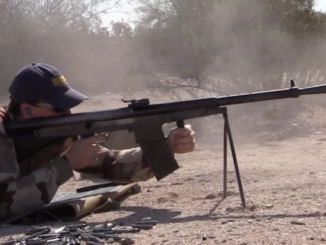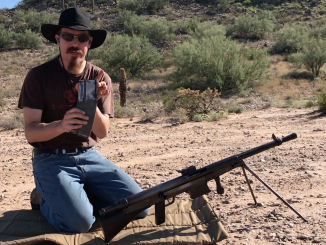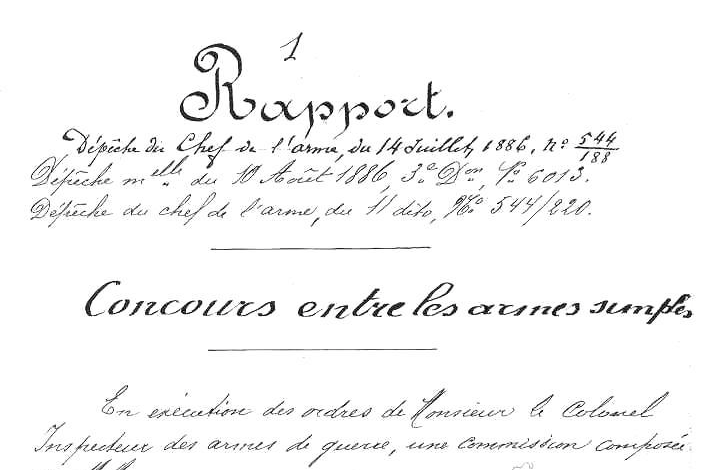The most popular shotgun made by the French Darne company was their 1897 sliding breech side-by-side, which saw sales and use worldwide. Before that, however, Darne invented a rotating breechblock system – first a series of external hammer varieties in the 1880s and then this hammerless Model 1892. It is a great example of a functional, creative, and interesting system that simply never became popular.
Related Articles

Light MGs
Mythbusting with the .30-06 American Chauchat: Reliability Test
Everyone knows, of course, that the Chauchat is the worst gun ever, and can’t normally get through an entire magazine without malfunctioning. Well, let’s try that out…and with an ever worse culprit; an M1918 Chauchat […]

Light MGs
M1918 Chauchat: Testing a New Magazine
Today I am testing out a new .30-06 Chauchat magazine converted from a Johnson M1941 machine gun magazine. The workmanship on this new mag is excellent, and much more extensive than I had initially realized […]

Bolt Action Rifles
Belgian 1886 Rifle Trials Report (Translated to English)
Our friend Thibaud has spent some time translating a report from the Belgian 1886 rifle trials into English – thank you, Thibaud! He notes that the text has a lot of specifically Belgian terminology and […]

I feel a little ‘funny’ to be first (if first) commenter, but cannot help it. This an extremely intelligent solution to shotgun mechanism. It is handy, compact and strong.
What I also laud is that Ian reached ‘inside’. This is where the gems lie.
Ian seems to fit his videos right at the center of the History/Engineering/Guns Venn Diagram. My son just started watching all these videos just because he wanted to learn all the different ways guns work.
This 20 gauge look light and small.
Why are we so focused today on 12 gauge to perform tasks on which our predecessors favoured both 20 and 16 gauge?
“Why”
I would bet: marketing, which states Bigger Is Better.
I believe the 12 gauge also fits the 00 shot better. So for security, 12 gauge works better. Also in Europe they have a much higher population density so larger guns could be a hindrance.
From what I heard, for bird shooting, 20 gauge kills where 12 gauge wound due to bigger dispersion.
Not sure where you live, but around here, (western USA), the 20 gauge is very popular. The 16 gauge has fallen out of favor simply because the longer 20 gauge shells overlap that round in performance. I still use my 16 gauge doubles for upland bird hunting since that’s what I grew up with, but the younger folk tend to choose the 20, (the guns and ammo are cheaper and more abundant).
I’m glad that Ian is dispelling the myth that “shotguns are boring” … nothing could be further from the truth. There is a lot of mechanical ingenuity in shotgun design, and along with .22 rifle design, it is underappreciated.
It appears 20ga is coming back; spotted it with at least one maker labelled as “self-defence”. for close encounter it is plenty of gun.
As I recall years ago I had a chance to try sample of self-loading Franchi in 20ga. I loved the thing. So quick, so easy to shoot like nothing before and after.
There is the small matter of needing to be extremely careful to keep 12g and 20g cartridges and guns very definitely seperate
a 20g case will lodge just ahead of a 12g chamber and split the barrel if anyone fires a 12g behind it.
16 and 20 are lovely to shoot, especially with fast game like driven grouse – but I wouldn’t blame anyone for not wanting any 20g cartridges in the house.
Just my thought on why “12-gauge”. History. The english Tower muskets from about 1706 until they were replaced by rifled weapons in the early 19 century were 12 gauge, firing 14 gauge balls (smaller ball to allow for fouling). The French use a 16-gauge as standard. Thus will all those military/surplus smooth bore muskets around 12 gauge (or more correctly “12 bore”) became the de facto standard, whereas 16 was more common on the continent. Meanwhile a gentleman would prefer something lighter that a big heavy military weapon for bird shooting, hence the 20 & 28 bore and even as small as 68-gauge (.410).
Interesting!
Does not look bad at all.
I wonder.
Was it weak or expensive or did it have any other significant draw backs since it did not catch on?
I also wonder if the sliding breach was any better?
If it is this type of gun:
http://firearmshistory.blogspot.se/2010/07/actions-sliding-barrel-breech-action.html
Then it seems it would be more convenient to load and reload the rotating breach gun.
My guess is that this design was not as durable.
The toggle-locked, sliding breech guns are still being made:
http://www.fusildarne.com
Probably so.
That is really amazing.
https://www.youtube.com/watch?v=TafnrEUtrqc
When I see that mechanism in action though it does not look so stupid either.
After all you only have to do a movement in only one direction (backwards / forwards instead of back then side then side then forward).
Also with both of these guns you do not have to break the action open like on “normal” shotguns.
I can imagine that reloading can be quite swift after all.
“The toggle-locked, sliding breech guns are still being made”
In many variations, according to http://www.gundigest.com/gun-digest-classics-articles/the-darne-gun/2
“(…)Darnes are made in all gauges extant — 10, 12, 12⁄3″, 16, 20 and 28, plus one you won’t want — 24(…)”
It looks like it; thanks for showing.
I like this better than the sliding block. Good clear
access to the chambers. It also seems less complicated.
I was never a big fan of the sliding block but the are lively andlight.
Hmm… Rotating the breech seems to be a good idea in terms of simplicity and not mashing your fingers when opening the action. The problem is if the rotating block gets jammed…
Given a choice, I wonder if having a sliding breech beats having a break-action in terms of receiver durability whenever the shotgun is roughly handled. I refer to the idea of “endurance tests” where the test subject gun is abused half to death (like getting smashed into tree trunks for thirty seconds continuously) to simulate wear and tear in the field…
re. break-action shotgun durability
Like everything related to mechanical devices, the answer is: It depends. ^__^
Not all break-action shotgun locking devices are the same, and some are a lot more durable than others. It comes down to a few things: Design, materials, and fitting.
For many break-action double guns, the “locking mechanism” boils down to a single shallow wedge that’s held in a square hole or notch with nothing other than spring pressure. Depending on how well the parts are fitted, if the gun is used for a lot of shooting these will beat themselves loose and the locking engagement surfaces may become so negative that the gun will pop open when it’s fired, (never a good thing). Other designs use actual cross bolts and/or double or triple locking surfaces that at lease won’t pop open when they get loose.
If I were a betting man, I’d bet that the toggle-locked sliding breech guns would stay tight longer than an equal quality break-action gun.
Now, if we’re talking about resistance to abuse, shotguns in general don’t like to be abused much at all. The barrels are very thin and light and will bend and dent very easily. If you drop or fall on your gun, check it on paper. It will most likely no longer shoot where it’s pointed. Time to get it to someone who knows how to correct that problem. ^__^
I happen to own CZ over/under which has a combination lock: wedge in bottom (fitting into tongue in barrel block) and Kersten (Greener) lock on top. I am not aware of anything that strong, but nothing is really fool-proof. The receiver has to be meticulously cleaned inside after every use. To get small rock between both groups would be bad news.
I suppose you mean to say that getting ANYTHING stuck in the action like that would break the gun or simply render it inoperable for a few hours, which is bad when something happens to be in the process of charging you like a wild boar…
This particular gun (I am lazy to go down to vault and look at type number) is designed for interchangeable ball barrels. That’s the main reason for locking redundancy. So yes, as you say it is potentially designed for hunting boars.
Chances are that large obstacle in breach would be spotted; but then it will normally never come to contact with dirt. I used it in past mainly for occasional trap shooting without problem.
Ian, I once actually got to see one of the sliding breech shotguns operated on a regular basis. Sometime around the mid to late 90’s the SASS club that I shot at had a member that shot one of the sliding breech shotguns at our matches. Having never seen anything like his shotgun I ask him about it’s history. He stated that this make of shotgun was supposedly very popular in French colonies in Africa. The sliding breech allowed for extraction of paper shells that might has swollen due to high humidity in the tropics. Whether there is any truth in this account remains to be seen, but it made a certain amount of sense due to the force that could be exerted to open the breech to extract spent shells. It was really cool to watch him operate that shotgun in Cowboy matches.
At ages of this mechanically very sturdy looking shotguns made, there were only hard paper cased shells which subject to swell with repeated use or only getting wet. In case using of a somewhat slightly deformed shell, this action would fail to force it into the chamber, whereas break open or sliding types would not by cause of their camming features. This would be the weak point for this very well designed mechanism.
In fact, the following “Sliding Breech” models should be designed mostly to overcome the “Weakness to chamber the deformed cased shotshells”, since its toggle mechanism would provide incredible power level to push the such kind of cases into the chamber.
The development of improved 12ga and 20ga loads doomed the 16ga. The newest rising star is the venerable 28ga. Once pretty much relegated to trap and skeet, it has found new favor as a light, highly responsive sporting arm.
My father in law who lives near Cognac in S W france has a darne sliding breech 12 bore with a good story
The priest in their village was an avid hunter as were many village priests in those days In or about 1943 he helped the son of M Darne to avoid STO ie oblitory work in germany
After the war M Darne gave him one of his shotguns in thanks
It was uningraved as befitting as my father in law says a simple man of god
At his death he gave the gun to my father in law and its sitting in his closit now as i drool
That’s amazing story of service and loyalty. Besides, I did not know French were obliged to forced labour in Germany during WWII (my father was too, btw). Anything with history is my ‘cup of tea’.
During the first war the father of my father in law as mayor of his village was alloted a number of german wapr prisoners about 12 they think
They worked on various farms in and around the village of Breville and also built new stables for
the father of my father in law